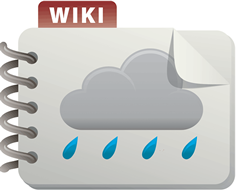
Difference between revisions of "Typical maintenance problems and activities for infiltration practices"
m |
m |
||
| Line 1: | Line 1: | ||
| − | + | <font size=3>'''Typical maintenance problems and activities for infiltration practices'''</font size><br> | |
| − | + | Link to this [[Typical maintenance problems and activities for infiltration practices|table]] | |
| − | Link to this [[Typical maintenance problems and activities for infiltration practices|table]] | ||
<table class="sortable"> | <table class="sortable"> | ||
| Line 20: | Line 19: | ||
<tr> | <tr> | ||
<td>Erosion of catchment area contributing significant amount of sediment</td> | <td>Erosion of catchment area contributing significant amount of sediment</td> | ||
| − | <td>In case of severely reduced drawdown time, scrape bottom of basin and remove sediment. Disc or otherwise aerate/scarify basin bottom. | + | <td>In case of severely reduced drawdown time, scrape bottom of basin and remove sediment. Disc or otherwise aerate/scarify basin bottom. De-thatch if basin bottom is turf grass. Restore original design cross section or revise section to increase infiltration rate and restore with vegetation as necessary.</td> |
<td>Upon identification of drawdown times longer than 48 hours or upon complete failure</td> | <td>Upon identification of drawdown times longer than 48 hours or upon complete failure</td> | ||
<td>1,2,3,4,5,6</td> | <td>1,2,3,4,5,6</td> | ||
| Line 46: | Line 45: | ||
<tr> | <tr> | ||
<td>Unexpected flow paths into practice</td> | <td>Unexpected flow paths into practice</td> | ||
| − | <td>Correct earthwork to eliminate | + | <td>Correct earthwork to eliminate unexpected drainage or created additional stable inlets as necessary</td> |
<td>As necessary</td> | <td>As necessary</td> | ||
<td>1,2,3,6</td> | <td>1,2,3,6</td> | ||
| Line 59: | Line 58: | ||
<tr> | <tr> | ||
<td>Severe weed establishment</td> | <td>Severe weed establishment</td> | ||
| − | <td>Limit the ability for noxious weed establishment by properly mowing, mulching or timely herbicide or | + | <td>Limit the ability for noxious weed establishment by properly mowing, mulching or timely herbicide or hand weeding. Refer to the [http://www.mda.state.mn.us/plants/pestmanagement/weedcontrol/noxiouslist.aspx MDA Noxious Weed List]</td> |
| − | <td> | + | <td>Bi‐monthly April through October</td> |
<td>2,6,8</td> | <td>2,6,8</td> | ||
</tr> | </tr> | ||
</table> | </table> | ||
| − | <font size=1><sup>1</sup> | + | <font size=1><sup>1</sup>1=Infiltration Basin; 2=Bioinfiltration Basin; 3=Infiltration Trench; 4=Dry Well; 5=Underground Infiltration; 6=Dry Swale with Check Dams; 7=Permeable Pavement; 8=Tree Trench/Tree Box</font size> |
| − | |||
| − | |||
| − | |||
| − | |||
| − | |||
| − | |||
| − | |||
| − | |||
| − | </font size> | ||
[[category:Table]] | [[category:Table]] | ||
Revision as of 12:53, 21 September 2016
Typical maintenance problems and activities for infiltration practices
Link to this table
| Inspection Focus | Common Maintenance Problems | Maintenance Activity | Recommended Maintenance Schedule | Applicable Infiltration Practices1 |
|---|---|---|---|---|
| 'Drainage Area and Drawdown Time' | Clogging, sediment deposition | Ensure that contributing catchment areas to practice, and inlets are clear of debris | Monthly | 1,2,3,4,5,6,7 |
| Erosion of catchment area contributing significant amount of sediment | In case of severely reduced drawdown time, scrape bottom of basin and remove sediment. Disc or otherwise aerate/scarify basin bottom. De-thatch if basin bottom is turf grass. Restore original design cross section or revise section to increase infiltration rate and restore with vegetation as necessary. | Upon identification of drawdown times longer than 48 hours or upon complete failure | 1,2,3,4,5,6 | |
| 'Pretreatment' | Pretreatment screens or sumps reach capacity | Remove sediment and oil/grease from pretreatment devices/structures. | Minimum yearly or as per manufacturer's recommendations | 1,2,3,4,5 |
| Vegetative filter strip failure | Reduce height of vegetative filter strip that may be limiting in‐flow. Re‐establish vegetation to prevent erosion. Leave practice off‐line until full reestablishment. | Mow grass filter strips monthly. Restore as necessary | 1,2,4,6 | |
| 'Site Erosion' | Scouring at inlets | Correct earthwork to promote non‐erosive flows that are evenly distributed | As necessary | 1,2,3,6 |
| Unexpected flow paths into practice | Correct earthwork to eliminate unexpected drainage or created additional stable inlets as necessary | As necessary | 1,2,3,6 | |
| 'Vegetation | Reduced drawdown time damaging plants | Correct drainage issues as described above | Replace with appropriate plants after correction of drainage issues | 2,6,8 |
| Severe weed establishment | Limit the ability for noxious weed establishment by properly mowing, mulching or timely herbicide or hand weeding. Refer to the MDA Noxious Weed List | Bi‐monthly April through October | 2,6,8 |
11=Infiltration Basin; 2=Bioinfiltration Basin; 3=Infiltration Trench; 4=Dry Well; 5=Underground Infiltration; 6=Dry Swale with Check Dams; 7=Permeable Pavement; 8=Tree Trench/Tree Box